Tamarind is a popular ingredient used in Thai cooking in many savory dishes as a souring agent. Learn how to make tamarind paste from pulp using blocks of tamarind.
Tamarind, a popular fruit grown throughout Southeast Asia, its many uses, and why it is an essential ingredient in Asian cooking. Click here to read about tamarind and how to use it in cooking.

Try these popular Thai recipes using taramind: Pad Thai (there's tamarind in the Pad Thai sauce), Make your own Pad Thai sauce, Easy Thai tamarind dipping sauce, Tom Yum soup instant pot, and Nam Jim Jaeow recipe.
Jump to:
- Why You'll Love This Tamarind Paste Recipe
- What is Tamarind Paste?
- What is Tamarind?
- Sweet Tamarind vs Sour Tamarind
- Tamarind paste vs Tamarind concentrate
- Ingredients for Homemade Tamarind Sauce
- How to Make Tamarind Paste from Pulp
- Extra steps to help preserve tamarind paste longer
- Helpful Kitchen Notes and Tips
- Helpful Kitchen Tools for Making Tamarind Paste
- Variations
- Substitutes for tamarind paste
- How to Store tamarind paste
- Different ways to use tamarind paste
- Frequently Asked Questions
- More Thai Recipes You'll Love
- How to Make Tamarind Paste from Pulp
- Thai recipes using tamarind paste
Why You'll Love This Tamarind Paste Recipe
- Complete control of your paste. You can make it a thick or thin paste and modify the consistency as much as you'd like!
- It's fresh, and no chemicals are added!
- The paste lasts for a long time, up to 3 weeks
- The sauce can be put in the freezer for up to 6 months!
What is Tamarind Paste?
Tamarind paste is a concentrated form of tamarind pulp. It combines boiling water with the pulp to loosen the texture and turn it into a thick sauce with a tangy, slightly sweet tamarind paste.
Tamarind is popular in Indian, Malaysian, Thai, and other Southeast Asian cuisines. It offers a unique sour taste, adding depth and complexity to many savory dishes.
What is Tamarind?
Tamarind is a sticky fruit encased in soft brown pods grown on large tamarind trees. They thrive in abundant tropical regions. The paste comes from the ripe tamarind fruit. For cooking, the paste is mixed with warm water and then transformed into a smooth, liquid consistency known as tamarind pulp or concentrate. Read more about tamarind and how to use it in Thai cooking here.
The versatility of tamarind makes it a popular ingredient in sweet and savory dishes, offering a distinct and delightful taste to many dishes in Thai, Malaysian, Laos, Cambodian, and Indian cuisine.
Sweet Tamarind vs Sour Tamarind
Fresh tamarind fruit is often used in its raw form, where the tangy and slightly sweet taste adds a unique flavor to various cuisines. The young raw tamarind is crispy, sour and can be eaten as snacks.
When the fruit is ripe, the tamarind becomes softer and pasty, making it easier to extract the pulp. The sour ripe tamarinds are used to make tamarind paste or concentrate. They are processed into tamarind blocks by compressing the fruit pulp. The sweet tamarind is used to make candy and sweet treats.
Tamarind paste vs Tamarind concentrate
There is often confusion about tamarind paste and tamarind concentrate in recipes. In most cases, they are the same. Both are tangy tamarind liquids extracted and combined with water, ready for cooking. Occasionally, they may also go by tamarind juice or tamarind sauce, depending on the specific recipes or chefs.
Tamarind juice, however, is the tamarind concentrate that has been diluted with sugar and water to make a refreshing sour and sweet drink. On the other hand, tamarind sauce typically refers to a dipping sauce recipe where tamarind is one of the main ingredients.
Ingredients for Homemade Tamarind Sauce
To make your own tamarind paste, you'll need only two things. Tamarind paste and hot water, that's it.
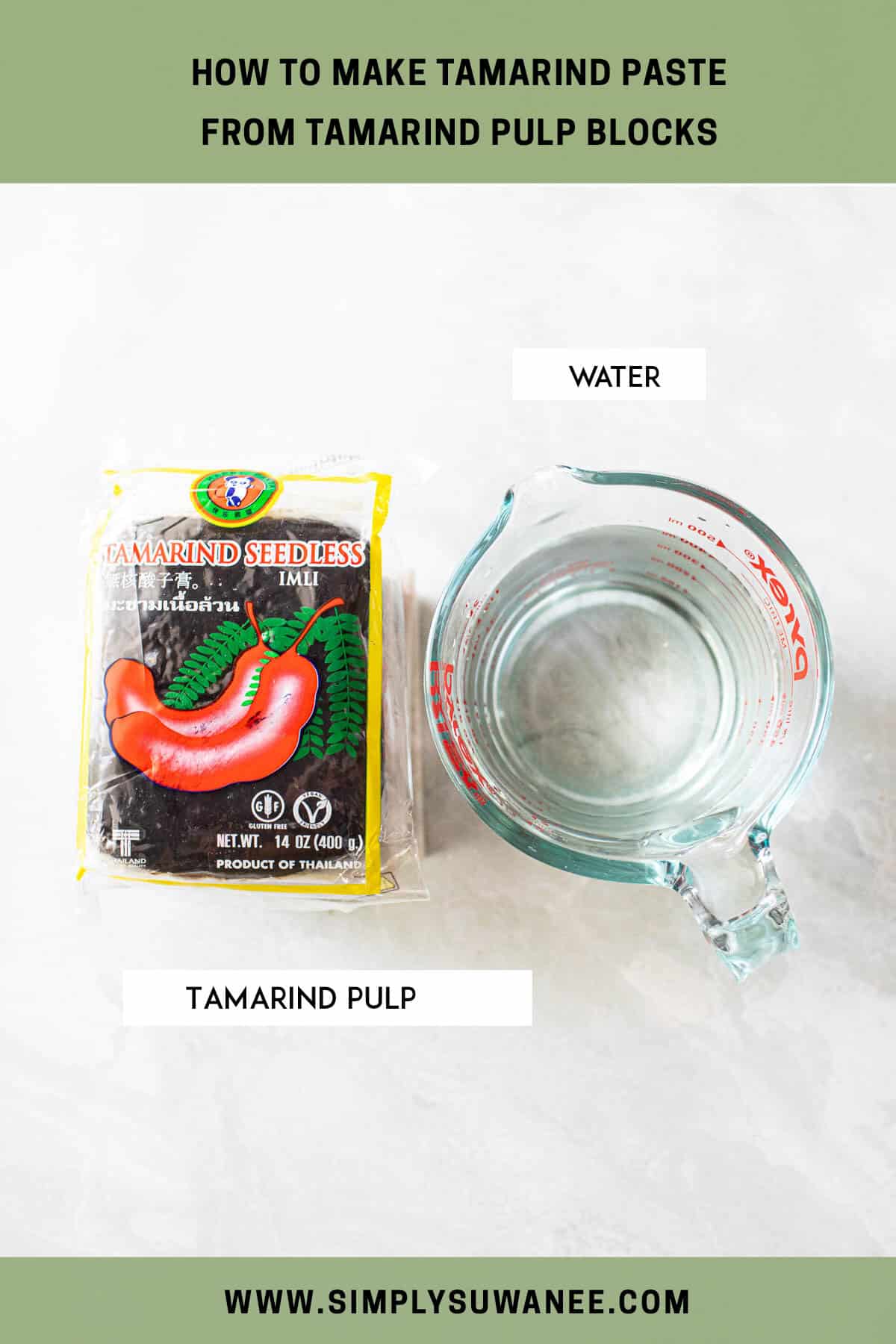
- Tamarind pulp. These typically come in square blocks wrapped in plastic bags. There are several brands, but they generally look the same as dark pasty tamarind. Always pick the seedless version. (See image above.)
- Hot water.
How to Make Tamarind Paste from Pulp
Follow these simple steps to create your own tamarind paste. I used the store-bought tamarind paste instead of the tamarind fruit pods. The blocks are made with pure tamarind paste and packaged into thick square blocks. They are for sale at most Asian grocery stores.
Step 1. Boil enough water to have 2-3 cups of hot water. While the water is going, cut the tamarind block in half and place it in a large bowl.

Step 2. Pour boiling water over the tamarind pulp in the bowl. Use a heat-safe bowl and a wire rack under the bowl to protect your counter. Soak the tamarind for 15-20 minutes, allowing the pulp to soften and release its flavor.
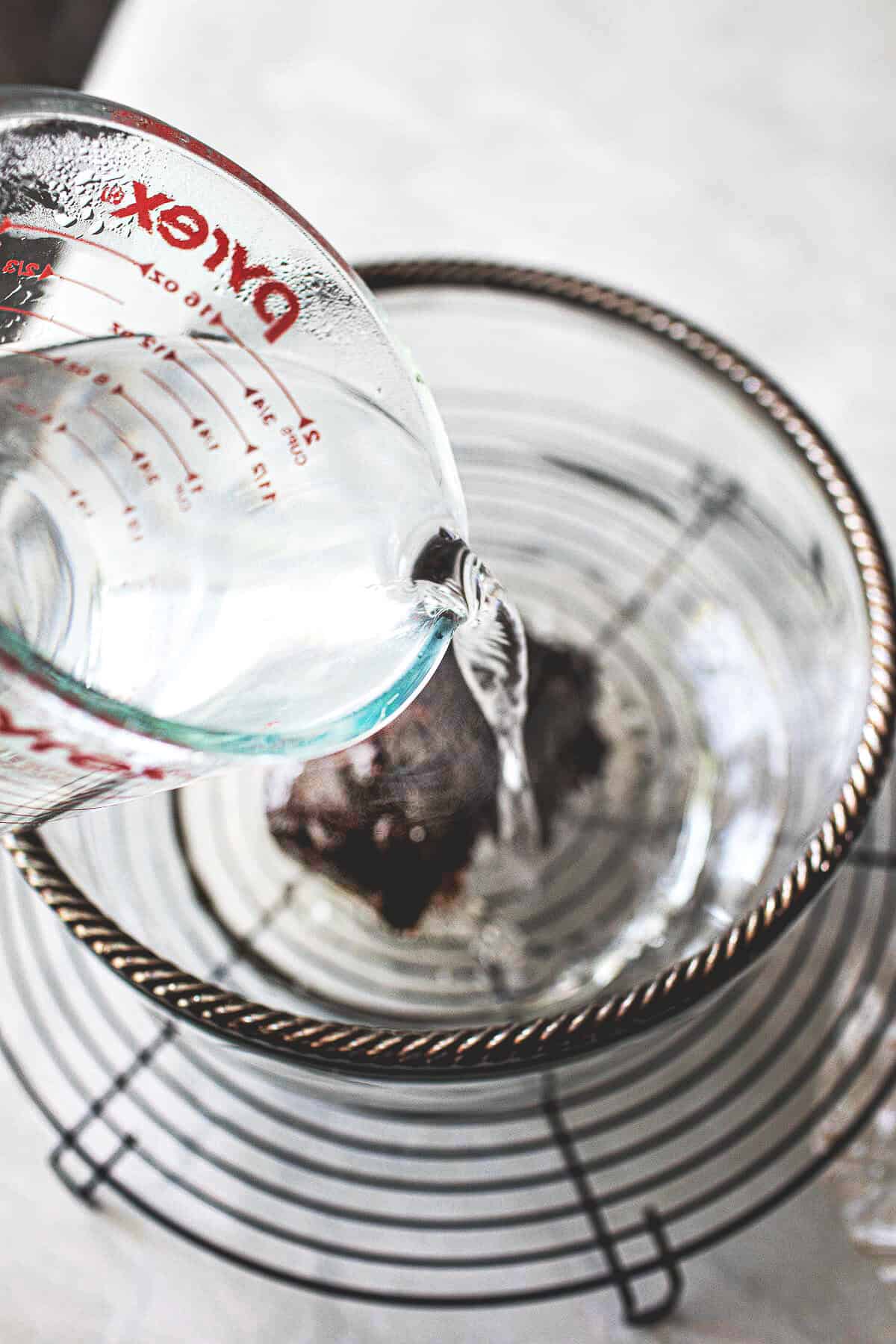
Step 3. Once the water is cool enough to handle, use a fork or your fingers to break the tamarind paste into small pieces. Mesh the paste until soft and the fiber of tamarind pulp and seeds have loosened. You'll get a fibrous sauce like the image below.
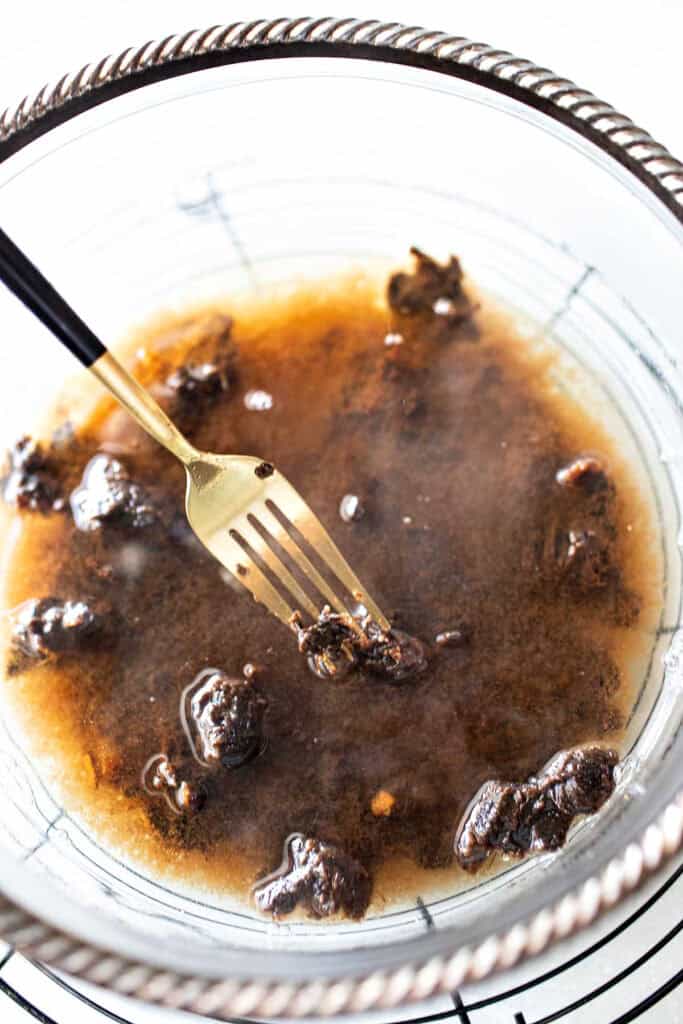
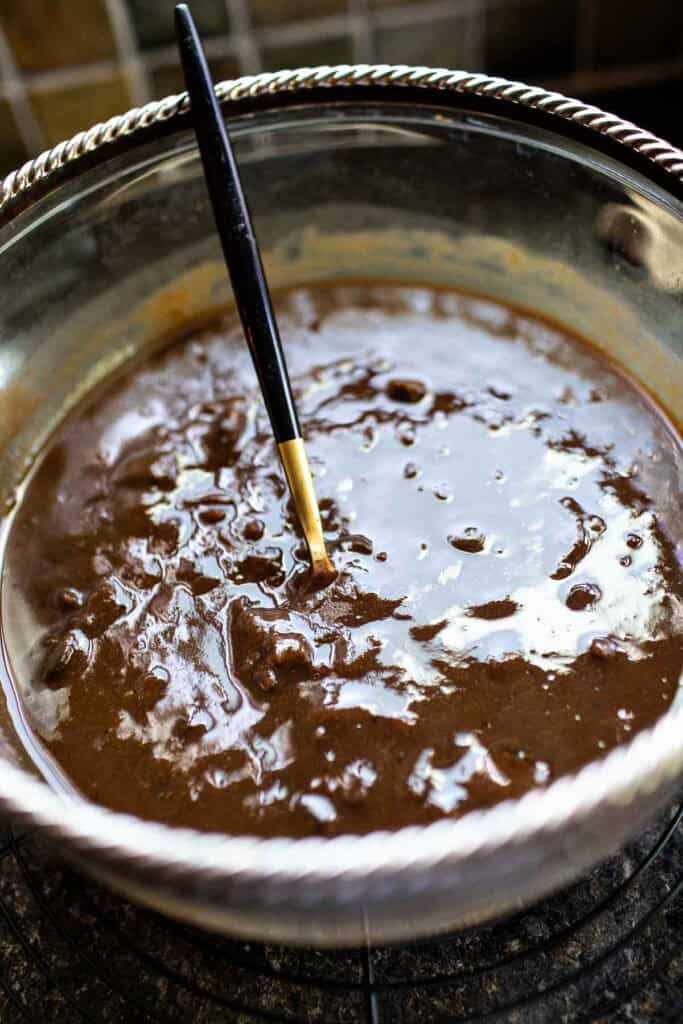
Step 4. Place a clean glass bowl in the bottom of the strainer, then pour the tamarind puree through a fine mesh strainer over a medium bowl. Doing it in the sink helps with the cleaning-up process. This part tends to get a little messy. Don't wear white clothes and put on your apron! (:

Step 5. Next, we'll extract the tamarind into a liquid concentrate by meshing, pushing, rubbing, and squeezing the gooey brown sauce in the fine mesh strainer into a clean bowl at the bottom. Use your fork and your fingers to squeeze every last ounce out. Check the bottom of your strainer. This is where a lot of the paste-like to hide! (:
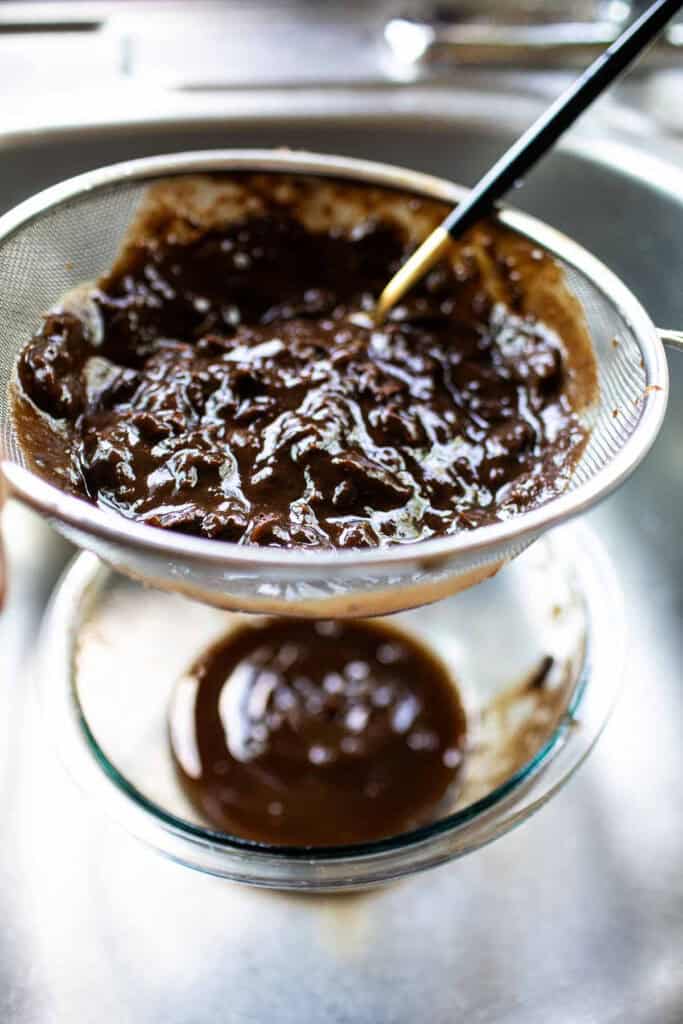
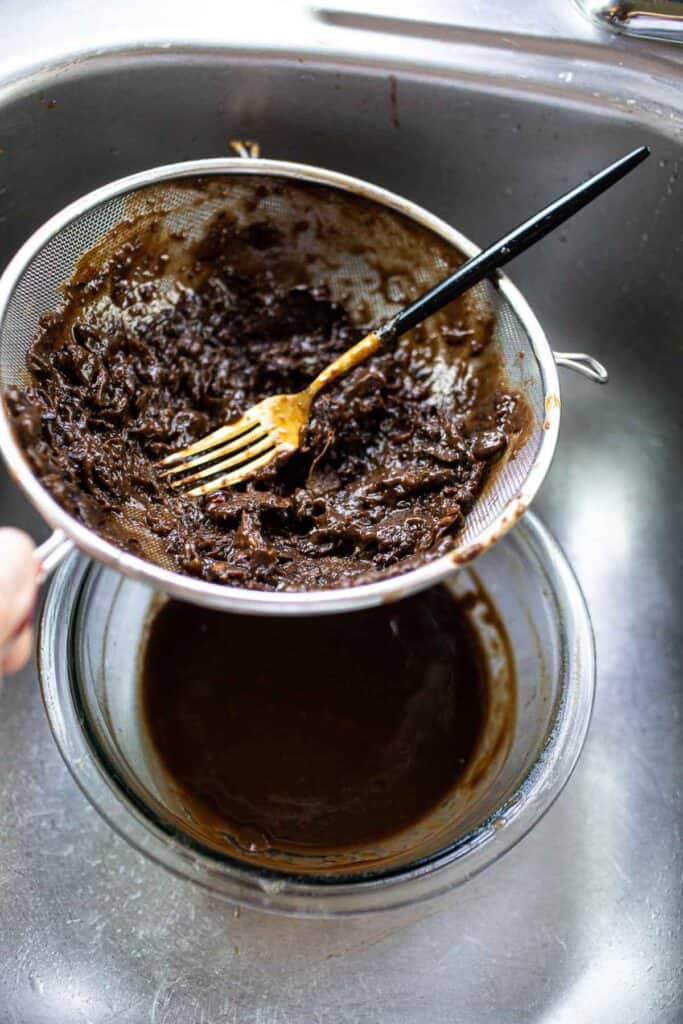
Step 6. Pour the tamarind pulp into glass jars, cover, and leave in the fridge for up to 2 weeks. Discard the solids in the strainer. That's it. It's ready for use! You can stop here or take it further to keep the tamarind longer.

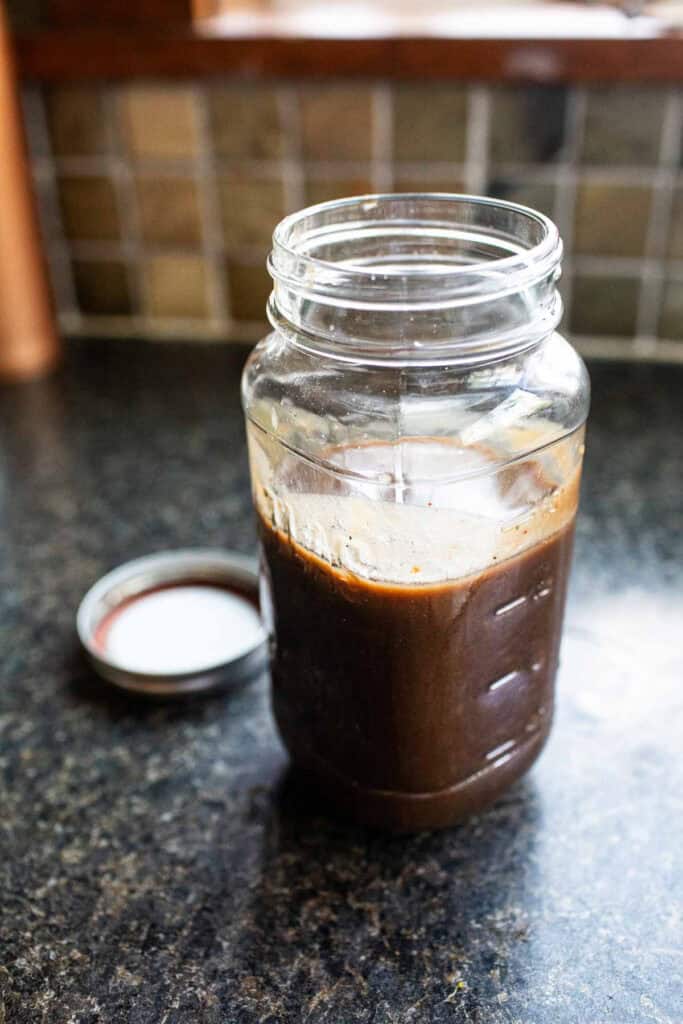
Extra steps to help preserve tamarind paste longer
Steps 7-9 are optional. If you don't use tamarind paste as often as I do in your cooking, this step is recommended as it helps to keep the tamarind paste last longer in the refrigerator.
Step 7. Boil the tamarind concentrate to help it last longer in the refrigerator and freezer. Mine never lasted more than 3 weeks, so I hardly ever boiled my tamarind pulp. See the section on how to use your tamarind concentrate below.
Step 8 Transfer the tamarind water to a saucepan and bring it to a gentle boil over medium-low heat. Let it simmer for 5 minutes until the mixture thickens slightly. Remove from stovetop.
Step 9. Let the paste cool completely. Once cooled, transfer it to a tight container or glass jar with a lid. Cooked tamarind paste can be stored in the refrigerator for up to 6 months.
Helpful Kitchen Notes and Tips
- If you don't use tamarind often, reduce this recipe in half and use only ¼ of the tamarind paste instead of ½ of the amount specified in my recipe card.
- Keep the left tamarind paste in a tightly wrapped package for your next use. It has a long shelf life of up to 3 months in the pantry and up to 6 months in the refrigerator.
- When purchasing tamarind pulp, look for a Thai brand for the best results since we will use tamarind paste for Thai recipes.
- To break down tamarind pulp, use a potato masher or your hands to separate the pulp. Use kitchen gloves to squeeze the paste.
- Use cheesecloth instead if you don't have a fine mesh strainer. It might take some squeezing to extract the pulp, but it works!
- Protect your counter using a cooking wire rack to place under the glass bowl with hot water and tamarind pulp.
Helpful Kitchen Tools for Making Tamarind Paste
- Fine mesh strainer
- Glass mason jars for storage
- Small mason jars. You'll need 4 of these for the amount of tamarind paste extracted.
- Cheesecloth
- Glass bowl
- Cooking wire rack
Variations
- While the basic recipe for tamarind paste is the same, you can experiment with the water-to-pulp ratio to create a paste you like. The more water you add, the thinner your paste is.
- More water will also dilute the sourness of the flavor as well. So consider all these factors and play around with a consistency you love!
Substitutes for tamarind paste
- If you cannot make tamarind paste, you can find store-bought options in Indian grocery stores, Asian markets, or Amazon. However, making your own tamarind paste gives a fresher and more authentic flavor profile.
How to Store tamarind paste
- Store your homemade tamarind paste in a tightly sealed container or plastic jar in the refrigerator. It can last for several months when properly stored.
- Store unused tamarind paste blocks in a plastic bag at room temperature. It has a long shelf-life of up to 6 months.
- You can also freeze tamarind paste. Store them in ice cube trays. Once frozen, remove the tamarind cubes and place them in glass jars or freezer-safe Ziploc bags for use later.
Different ways to use tamarind paste
- Use the homemade tamarind paste to make stir-fry sauces like this Pad Thai recipe Pad Mee Korat, or Thai swimming rama with spinach.
- Make delicious condiments like Nam Jim Jaeow and Nam Prik Pao.
- Make tamarind drinks! The tangy flavor of tamarind is a perfect compliment to your sweet tea, lemonade, cocktails, or juice. Tamarind also has extra health benefits. Read up more on tamarind here.
- Make a tamarind lemonade by adding tamarind concentrate with simple syrup or brown sugar. Use a 1-1-4 ratio: 1 part tamarind, 1 part sugar, and 4 parts water. Simmer on low heat until sugar dissolves, let cool, and serve over ice and mint sprig! Tasty!
Making tamarind pulp at home is a rewarding cooking project. By following the steps in this recipe, you will have a fresh homemade tamarind paste that elevates the flavors of your dishes to new heights of deliciousness. So, grab your tamarind pulp and water, and let's start!
Frequently Asked Questions
Yes. You can freeze homemade tamarind paste by transferring it to a freezer bag or an airtight container. It can be kept frozen for an extended period, giving you a ready supply whenever needed.
Tamarind flavor is tangy, slightly less sour than lime juice or vinegar.
You can use rice or apple cider vinegar, lemon, or lime juice as tamarind substitutes. In a pinch, you can use a combination of vinegar with a small amount of Worcestershire sauce as a substitute for tamarind.
More Thai Recipes You'll Love
- 5-minute satay sauce
- Thai Swimming rama with peanut sauce
- Thai Green Curry
- Tom Yum Soup
- Pineapple Fried Rice
- Massaman Curry
- More tamarind recipes you'll love. How to make the best Pad Thai sauce, tamarind dipping sauce, 10-minute Tamarind iced tea, authentic Shrimp Pad Thai recipe, and Pad Mee Korat.
** Love a recipe you've tried? Please leave a 5-star ?rating in the recipe card below and/or a review in the comments section further down the page. Or follow me on Facebook, Pinterest, or Instagram! *
Print
How to Make Tamarind Paste from Pulp
- Total Time: 30 minutes
- Yield: 2.5 cups 1x
- Diet: Low Calorie
Description
Tamarind is a popular ingredient used in Thai cooking in many savory dishes as a souring agent. Learn how to make tamarind paste from pulp using blocks of tamarind.
Instructions
- Boil enough water to have 2-3 cups of hot water. While the water is going, cut the tamarind block in half and place it in a large bowl.
- Pour boiling water over the tamarind pulp in the bowl. Use a heat-safe bowl and a wire rack under the bowl to protect your counter. Soak the tamarind for 15-20 minutes, allowing the pulp to soften and release its flavor.
- Once the water is cool enough to handle, use a fork or your fingers to break the tamarind paste into small pieces. Mesh the paste until soft and the fiber of tamarind pulp and seeds have loosened. You'll get a fibrous sauce like the image below.
- Place a clean glass bowl in the bottom of the strainer, then pour the tamarind puree through a fine mesh strainer over a medium bowl. Doing it in the sink helps with the cleaning-up process. This part tends to get a little messy. Don't wear white clothes and put on your apron! (:
- Next, we'll extract the tamarind into a liquid concentrate by meshing, pushing, rubbing, and squeezing the gooey brown sauce in the fine mesh strainer into a clean bowl at the bottom. Use your fork and your fingers to squeeze every last ounce out. Check the bottom of your strainer. This is where a lot of the paste-like to hide! (:
- Pour the tamarind pulp into glass jars, cover, and leave in the fridge for up to 2 weeks. Discard the solids in the strainer. That's it. It's ready for use! You can stop here or take it further to keep the tamarind longer.
Steps 7-9 are optional. If you don't use tamarind paste as often as I do in your cooking, this step is recommended as it helps to keep the tamarind paste last longer in the refrigerator.
Step 7. Boil the tamarind concentrate to help it last longer in the refrigerator and freezer. Mine never lasted more than 3 weeks, so I hardly ever boiled my tamarind pulp. See the section on how to use your tamarind concentrate below.
Step 8 Transfer the tamarind water to a saucepan and bring it to a gentle boil over medium-low heat. Let it simmer for 5 minutes until the mixture thickens slightly. Remove from stovetop.
Step 9. Let the paste cool completely. Once cooled, transfer it to a tight container or glass jar with a lid. Cooked tamarind paste can be stored in the refrigerator for 6 months.
Notes
- If you don't use tamarind often, reduce this recipe in half and use only ¼ of the tamarind paste instead of ½ of the amount specified in my recipe card.
- Keep the left tamarind paste in a tightly wrapped package for your next use. It has a long shelf life of up to 3 months in the pantry and up to 6 months in the refrigerator.
- When purchasing tamarind pulp, look for a Thai brand for the best results since we will use tamarind paste for Thai recipes.
- To break down tamarind pulp, use a potato masher or your hands to separate the pulp. Use kitchen gloves to squeeze the paste.
- Use cheesecloth instead if you don't have a fine mesh strainer. It might take some squeezing to extract the pulp, but it works!
- Protect your counter using a cooking wire rack to place under the glass bowl with hot water and tamarind pulp.
* Thank you so much for visiting my blog! This is truly a passion for me. If you have enjoyed these recipes and appreciate the hard work I put into them, I would love it if you would share them with your friends! Your recommendation is the highest review I could hope for, and I’d appreciate it! **
- Prep Time: 25
- Cook Time: 5
- Category: Sauces
- Method: Homemade
- Cuisine: Thai Food



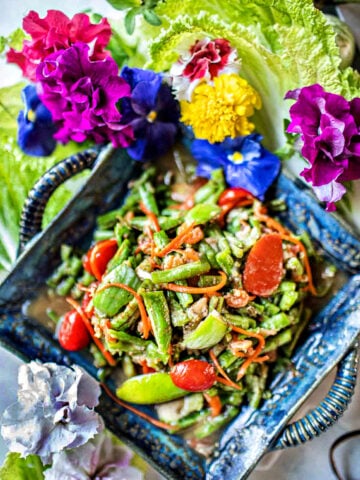





Pierre
We have a tamarind tree and usually the pods go to waste, now we can make them into a paste and store them, thank you, Suwanee!
Samantha
Loved this tamarind paste! A little messy in the kitchen, but worth it! Tmr sauce traded so much better than store bought!